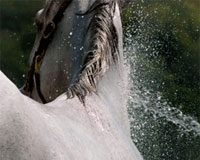Q: I am thinking about purchasing a 3-year-old Thoroughbred gelding. When he was 2 1/2, he was in race training and developed a hairline sesamoid stress fracture. The vet said to rest him six months, and he’s been rested for eight. He x-rayed clean now and was cleared for high level work. Will this old, potentially healed, injury ever come back to haunt me when he’s older? Is he more susceptible to injury on it? Is his ability limited because of it?
The proximal sesamoid bones are two round bones at the back of the fetlock. Sesamoid fractures are common injuries to race horses and are usually due as a result from opposing tensile forces that local ligaments place on these bones under high stress. Often just one sesamoid is fractured, but sometimes both are injured. These fractures occur on different places on the bone; sometimes at the upper tip, at the bottom, through the middle, along the side, or in multiple places. Depending on the location of the fracture and the age and use of the horse, these injuries can be treated conservatively with stall rest as your horse was, or with a cast or even surgical placement of screws.
After the sesamoid bone heals, secondary problems such as osteoarthritis of the fetlock joint and desmitis (ligament inflammation) of the suspensory ligament that runs along the back of the fetlock can cause lameness and performance issues. A great proportion of these secondary problems are relative to where the original fracture was located. Small fractures occurring at the top or along the side of the sesamoid bone heal the best and have the least amount of secondary problems. A hairline stress fracture is one that has not breached the entire bone, making prognosis even more favorable.
If the post-recovery radiographs of this horse are clean (feel free to have another vet evaluate them for a second opinion) and the horse comes up sound during a lameness exam (be sure to have a pre-purchase exam done on him by an impartial third party), you are likely to have minimal problems with this old injury. If you do choose to purchase this horse, start him back to work very slowly and methodically. You also might consider placing the horse on joint supplements at an early age.
Ask your horse health questions on the HorseChannel.com Forums >>
See more Expert Q&As >>
Submit your Ask the Expert question >>







Sounds like an iffy purchase but sometimes it’s just worth it.